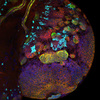This decommissioned ERA site remains active temporarily to support our final migration steps to https://ualberta.scholaris.ca, ERA's new home. All new collections and items, including Spring 2025 theses, are at that site. For assistance, please contact erahelp@ualberta.ca.
Images of Research Competition 2016
University of Alberta graduate students made 114 submissions to the Images of Research Competition 2016. The submissions highlighted that graduate student research at UAlberta takes place in studios and science labs, in the field and on the ice. From steel joints to self-determination; forest fire sensors to fossil record research; from drag kings to disease-resistant peas, UAlberta graduate student research is diverse and global. A multi-disciplinary 5 person adjudication committee reviewed all submissions and selected winners. The University of Alberta community voted for the People's Choice Award and the winning image garnered 122 votes out of 765 votes. The winning and semifinalist images are available in ERA (the University of Alberta’s digital repository) after the Images of Research exhibition.
Items in this Collection
- 1Aquaporins
- 1Artificial limbs--Automatic control
- 1Balsam poplar--Confocal fluorescence microscopy
- 1Biodiversity--Climatic factors
- 1Bluff Mountain, Crowsnest Pass, AB
- 1Canada--Crowsnest Pass--Repeat photography
-

2016-01-01
Meyer, Pony, Lazy Kitten Productions (Katie Cutting)
We can't overlook the value of DRAG KING performance for lesbian, feminist, and queer communities, particularly when we consider the historical and contemporary regulation of gender and sexual norms and the legal and social persecution of female cross-dressers, lesbians, masculine women, and...
-

2016-01-01
My current research project focuses on transformation, efficacy and environmental biosafety of transgenic disease resistant peas. During course of my PhD here at UA, I spent a semester at University of Hannover, Germany as an exchange research student in winter 2013, learning how transgenic...
-

2016-01-01
Green's research is focused on campsites and shelters, transitional spaces, and extreme landscapes. His interests lie in the idea of camping and survival in wilderness spaces. Temporal and semi permanent architecture of the campsite and shack act as transitional sites - as spaces between the...
-

2016-01-01
My PhD research involves determining the effects of industrial noise on several owl species in the boreal forest of northeastern Alberta. Owls use vocal communication to attract mates and defend territories, and they use acoustic cues when hunting for prey at night. To determine whether owls...
-

2016-01-01
Plants have evolved a number of interesting features to help facilitate the passage of water and sugar around their tissues. One such molecular structure highlighted here in this balsam poplar leaf blade are aquaporins. As the name implies, aquaporins are small pores that carry water- but have...
-

2016-01-01
Advances in robotic medical technologies have enabled an emerging generation of upper limb prostheses capable of moving with the same complexity and fluidity as a human arm. Yet even the most advanced commercially available systems are unable to communicate sensations of touch and movement to the...
-

2016-01-01
This image is a composite image of two photos of the same sunflower (Helianthus annuus) plant. The aboveground green shoot was taken with a Nikon D90 SLR, and on the same day the belowground root was scanned using an Epson 550 Scanner after removing the soil by excavation. By stitching together...
-

2016-01-01
Current estimates suggest that one in every three species today is either threatened by, or considered at risk of, extinction. Despite such alarming statistics, and mounting evidence of a major biodiversity crisis currently taking place, our understanding of the factors that prevent species'...
-

2016-01-01
We have been studying a gene in zebrafish (called unc119b) that is required for many developmental processes, including eye formation. On the left, is a cross-section of a normal zebrafish eye at 3 days old that has been stained with fluorescent antibodies. The lens is surrounded by green (a lens...
-

2016-01-01
My research in the Hughes lab focuses on investigating the role of Moesin during nervous system development. Moesin is involved in maintaining cell integrity by linking membrane-associated proteins to the underlying actin cytoskeleton. We use fruit flies to study Moesin function as only one...